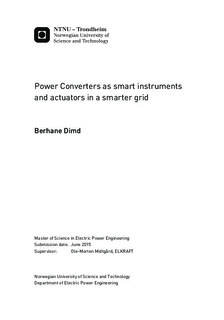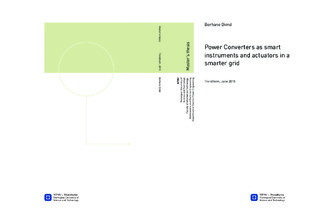| dc.description.abstract | Climate change is one of the biggest challenges facing the world. One of the biggest issues to address is energy. At the moment we get most of our energy from fossil fuels, like oil, coal and gas, but these release greenhouse gases that trap heat in the earth's atmosphere. To avoid dangerous levels of global warming and give a more secure future, we need to switch to clean, green renewable energy.
With the increasing penetration of renewable energies as distributed generation (DG) in smart grid scheme, technical problems arise in both distribution and transmission system level. Today's storage technologies are becoming more efficient and higher performing.
Power electronics based loads such as adjustable speed drives, rectifiers, power supplies, domestic appliances, and the like offer highly non-linear characteristics. These non-linear loads draw distorted currents from the grid and cause reactive power burden and excessive neutral current.
The purpose of this thesis is to study and analyze the potential of smart power converters and batteries at telecom sites, to aid the grid in power quality improvement. Power converters can provide more information about the grid quality and also contribute to grid quality. When connected to energy storage and renewable energy, the power conversion system represents an additional flexibility. Converter-battery combination is studied in SAF (Shunt active filter) configuration to compensate harmonic and reactive currents.
A control strategy based on p-q theory is used for extracting the three-phase reference currents for SAF, and performance evaluation is carried out with dq-PI and adaptive HCC controllers in Matlab/Simulink 2015a environment.
When used in three-phase, three-wire configurations, the two controllers give a relatively similar compensation characteristics. The THD (Total harmonic distortion) in the source current reduced from 28.08% to 2.24% with dq-PI and to 3.10% using adaptive HCC control for distorted source and unbalanced load conditions. However, under three-phase, four-wire systems, they give significantly different results. The THD in the source current reduced from 28.17% to 7.23% with dq-PI control and to 0.51% with adaptive HCC control for the same source and load conditions. These results point that, dq-PI control is not able to give the required compensation characteristics in a highly distorted and complex systems. Except for dq-PI control in three-phase, four-wire systems under distorted source and unbalanced load conditions, the THD in the source current is within the limits defined in IEEE-519. The overall obtained results have demonstrated the effectiveness of using telecom sites to aid in the improvement of grid power quality. | |

